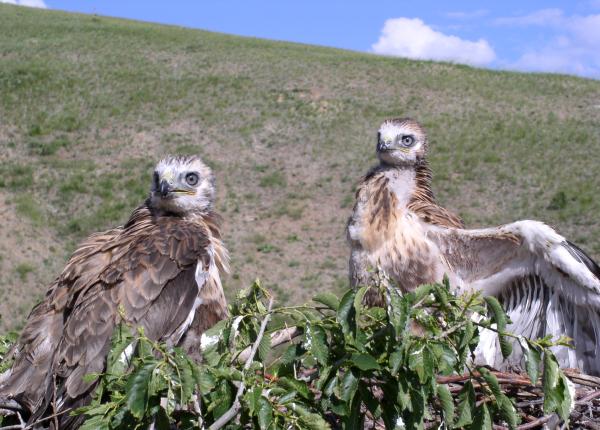Did You Know?
- Researchers have documented Upland Buzzards feeding on the eggs of other bird species
- Though not common throughout its range, in Nepal this species can be found at elevations over 5,000 meters above sea level.
- In Mongolia, where most of the population breeds, researchers have found that the principal prey is the Brandt's Vole. They have also determined that breeding success - including how well the nestlings grow, the clutch size, and how well the fledglings do - is highly dependent on how many voles are around.
How The Peregrine Fund is Helping
The Peregrine Fund has supported research on the Upland Buzzard in Mongolia. Additionally, our efforts in scientific research, habitat conservation, education, and community development help conserve birds of prey around the world. We also supply literature to researchers from our avian research library, which helps scientists around the world gather and share important information on raptor conservation. We also run the Global Raptor Impact Network which gives raptor researchers tools to more efficiently conduct their own studies while contributing to a global program. GRIN also provides citizen scientists a way to participate in raptor science and conservation.
Where They Live
The Upland Buzzard is found throughout much of the Indomalayan/Palearctic regions of the world. It can be found in a number of different countries throughout this region including: China, India, Mongolia, Russian Federation, Kyrgyzstan, Bhutan, Korea, Nepal, and Tajikistan among others.
This beautiful bird can be found in a number of different habitats including forest-steppe, open areas dotted with hills, deserts and semi-arid landscapes, grasslands, steppe, even lowland agricultural fields, among others. It usually spends its time in elevations between 1000–4500 m.
What They Do
Individual Upland Buzzards vary quite a bit in their plumage patterns and colors. They can range from being quite dark overall, to rather pale. However, all individuals have relatively long, barred tails and their legs are partially feathered. One of the key features of this buzzard is that it flies with its wings in a "V" shape.
This buzzard does engage in migratory movements and avoids areas that are covered with snow.
Why They Need our Help
The Upland Buzzard is categorized as a species of Least Concern by BirdLife International. However, there is still a lot to learn about the status of the species and the threats it might be facing across its range.
What They Eat
The Upland Buzzard is a skilled hunter and traps a number of different prey. Its diets is composed primarily of rodents such as voles, susliks (which are a type of ground squirrel), gerbils, pikas as well as young marmots and hares! It will also take amphibians, beetles, grasshoppers, and small birds, such as larks and pipits, when the opportunity arises. Researchers have documented this species feeding on larger birds as well, such as Willow Grouse and Tibetan Snowcock.
When on the hunt, it may spend time in flight, scanning the area below for something good to eat. Or, it sometimes prefers to sit on a perch, such as a rock, waiting for something to pass by.
Nests, Eggs, and Young
Upland Buzzards gather small sticks which they use to construct a relatively small nest which they build atop a rocky cliff, stony talus slope, under a bush, or even in a pile of rocks. Once the nest construction is done, they will line the nests with some interesting things such as wool, rags, or even dry manure.
The female will lay 2-4 eggs that are off-white and decorated with yellowish-brown spots. The eggs must be incubated for around 35–38 days. After the nestlings hatch, they will grow quickly and will be ready to fly from the nest for the first time when they are around 45 days old. .
Upland Buzzard the World Center for Birds of Prey
The World Center for Birds of Prey offers fun ways to learn about birds of prey. Interactive activities, tours, interesting videos and a children's room with activities from coloring sheets to quizzes to costumes and a touch table are available for the curious mind. We also have several birds of prey on display year-around, including a number of hawk species such as a Red-tailed Hawk and a Harris' Hawk. Knowledgeable staff and volunteers are on hand to answer any questions you may have about Upland Buzzards or any other bird of prey.
References:
BirdLife International. 2018. Buteo hemilasius. The IUCN Red List of Threatened Species 2018: e.T22695967A131937792. https://dx.doi.org/10.2305/IUCN.UK.2018-2.RLTS.T22695967A131937792.en. Downloaded on 26 August 2021.
Global Raptor Information Network. 2021. Species account: Upland Buzzard Buteo hemilasius. Downloaded from http://www.globalraptors.org on 26 Aug. 2021
Orta, J. and G. M. Kirwan (2020). Upland Buzzard (Buteo hemilasius), version 1.0. In Birds of the World (J. del Hoyo, A. Elliott, J. Sargatal, D. A. Christie, and E. de Juana, Editors). Cornell Lab of Ornithology, Ithaca, NY, USA. https://doi.org/10.2173/bow.uplbuz1.01









